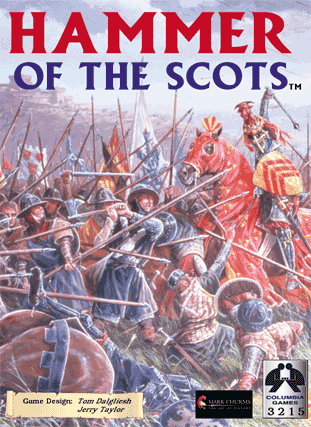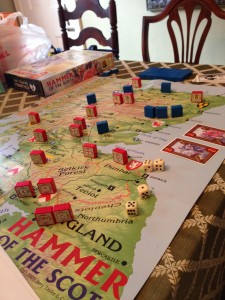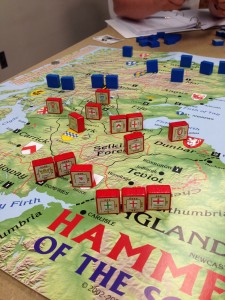
I learned the complicated rules of Hammer of the Scots, and was playing the side of the dreaded British. Since being a complete noob at the game, and playing one as well, this match up was even but sloppy.
We decided to play the Braveheart scenario, which only lasts from years 1297 to 1305 (which is when King Edward I dies of old age). The object of the game is for the British to suppress the Scottish uprising and for the Scots to survive until Edward I dies in 1305. There are a couple of ways to when a decisive victory, such as the Scottish king being killed or King Edward II is killed. Each year has five actions, unless event cards by both players are played at the same time. The winner is determined by how many nobles (14 total) are captured with William Wallace being the tie breaker. Now lets dive into the actual gameplay.
The game starts off with a major battle, which turns to be a bloody one at that. The English move into Annan to capture Robert the Bruce, this was a successful move thus spilling the first blood of the war. The rest of the year end up being more in favor of the Scots due to some luck from the druid gods. The Scots were able to take the nobles Ross and Angus in there home regions, with Wallace taking part in the capture of Angus. The Scots were also able to defeat the British infantry in Fife. The next move was good and bad for both sides. The Scots captured the noble Mentieth at Mentieth, which turns out to be one of the most valuable regions on the island. The British we able to capture the noble Comyn at Atholl, which was the most powerful noble in the game. The last two actions for the year were both terrible for the British: they lost the noble Buchan and lost troops at Galloway.
This brings us to the first wintering, which turns out to not be a very eventful one since both sides are trying to understand the rules. I soon learn that the wintering phase is the equalizer for the Scots.
On to the year 1298, which continues the downward slope for the British. Over the course of the year the British move troops to Mentieth and Dunbar (from England, the feudal pool is the saving grace for the Britts). Then the British lost the noble Atholl then gained Atholl at Atholl, but then lost the noble due to wintering regulations. The British also lost the powerful noble Comyn at Badenoch when surrounded by Scottish troops. The end of the year was a peaceful time due to the British moving troops into Mentieth and Annan to gain a foothold in the middle of the island.
The year of 1299 turned out to be a peaceful one since both players played event cards. This allowed for the English to move troops to Dunbar and Tevoit.
The next year, 1300, Wallace is spotted in Selkirk Forrest. British troops pursue from England forcing Wallace into Lothian. The Brits also gained a noble by the name of Buchan via the Herald card. In the process of chasing down Wallace, the British lose Argyll and Buchan (again) both at their home regions. Then the end of the first year of the century turned out to be fruitful for the British. Robert the Bruce, just as in real life, was the one who ended William Wallace’s rebellion, he did so in Lothian. The British end the year with a capture of the region of Galloway.
The year of 1301 was a bloody one, and the balance of power continued to flip flop. First the Scots take Galloway and Bruce, then the British take them both right back. The Scots clearly want to control Fife and send many reinforcements there to build up for defense or an attack. The British decide to weaken them a little by sending in the knights of York. The British are overpowered and the knights retreat back to Mentieth while losing some infantry at Fife. The very next turn, the troops at Fife decide to chase the retreating knights and finish them off in Mentieth, which was a crucial blow to the British campaign. The year ended in a truce card being played.
The following year ended up becoming a year of peace due to both players playing event cards.
In the year 1303, the King of England, still Edward I, is on his decline and realizes that he must become more aggressive in the suppression of the Scots. After losing Lennox to pillaging the British capture Mentieth at Lennox and then forces the noble Lennox back to Mentieth. They then chase after the noble and lose a battle at Mentieth, which was able to weaken the Scots enough to counter and take back Mentieth and gained the noble Comyn. The year then ended in peace.
With time winding down for Edward I, he begins to become even more aggressive with the troops from the feudal pool. At the beginning of 1304 the Bruce flips to Scottish alliance due to the Herald card only to be forcefully flipped back to the English. The next turn Comyn is captured by the Scots at Lochaber, but the British were able to take and protect the valuable Mentieth. After the win at Mentieth, morale is high for the British and they feel confident enough to go on the offensive to gain more nobles; they then move into and take both Lennox and Argyll and their nobles. Once again, the year ended in peace. A calm before the storm.
The last year of King Edward I’s reign, he can feel the grip of death closing in on him. He knows that to end the Scottish rebellion, he must make a drastic move to hold the nobles he has under his control. The year is relatively peaceful until the very end when all hell breaks loose in Mentieth with the Scots making one last attempt to claim the majority of the nobles. The whole year is spent on strengthening forces on both sides to meet at Mentieth which is currently controlled by the British. The British know that they hold the tie breaker with the elimination of Wallace, and know that the defender is always given the advantage. The battle is turned into a bloodbath and the Scots are beaten very handedly forcing the nobles to retreat. At the end of this year, 1305, the British have successfully squandered the Scots’ attempt at rebelling due to the tie breaker of William Wallace’s death.
This game is very interesting and will become very intense if both players get into the game. The cool thing about this war game is how historical it is. Even though this game is fun, it also is a history lesson. I came into the game only knowing what the movie Braveheart taught me, once I finished playing the game I learned what else was happening during the rebellion. The game did show some American qualities to it since there is a good amount of chance in the game with the rolling of die and the drawing of cards. The strategies of the game differ depending on the side chosen and also the scenario being played as well. It took us about three and a half hours to play the short scenario. I enjoyed playing the game, but did not like how unclear the rule book is. Overall, it was an exciting game, once you understand what the goals are.

